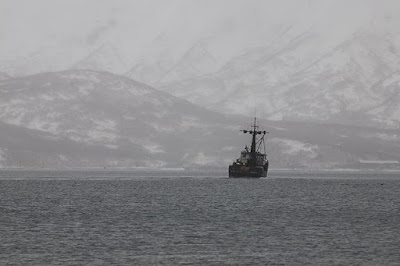Rock ptarmigan (Lagopus mutus)

There are both willow and rock ptarmigan in this area. Only the male rock ptarmigan has this distinct black eye patch. Normally rock ptarmigan gather in large flocks during the winter months.


We spotted these ptarmigan in the tundra behind the house. Originally it was a flock of about 15, only these three males were not scared away. We had been trying to get a closer look at these birds for some time. When we saw them we were able to watch them for some time, gradually getting closer and closer before we eventually scared them off.
Pigeon guillemot (Cepphus columba)

The pigeon guillemot has just begun to change from its grayish winter plumage to this sleek black. Many in the pass are in various stages of molting.
Ancient Murrelet (Synthliboramphus antiquus)

Ancient murrelets spend their lives at sea and come to land only to breed. They are active at night at their colonies. This adaptation for avoiding daytime predation by gulls and raptors makes them hard to observe on land. They can be identified by the distinctive nighttime vocalizations they use for sexual display and individual recognition.


On the 14th of April we headed in to town and noticed quite a change on the pass. All winter the water has been full with thousands of Oldsquaws or Long-tailed ducks. Their calls normally fill the air. On this day there was no sight or sound of them. In their place suddenly there were hundreds of Ancient murrelets. We hadn't seen any of these seabirds since fall. They dotted Isanotski Strait in flocks of 5 to 50. Two weeks later they are still out there in large numbers.

























































